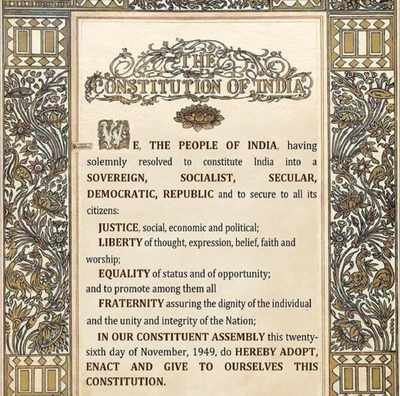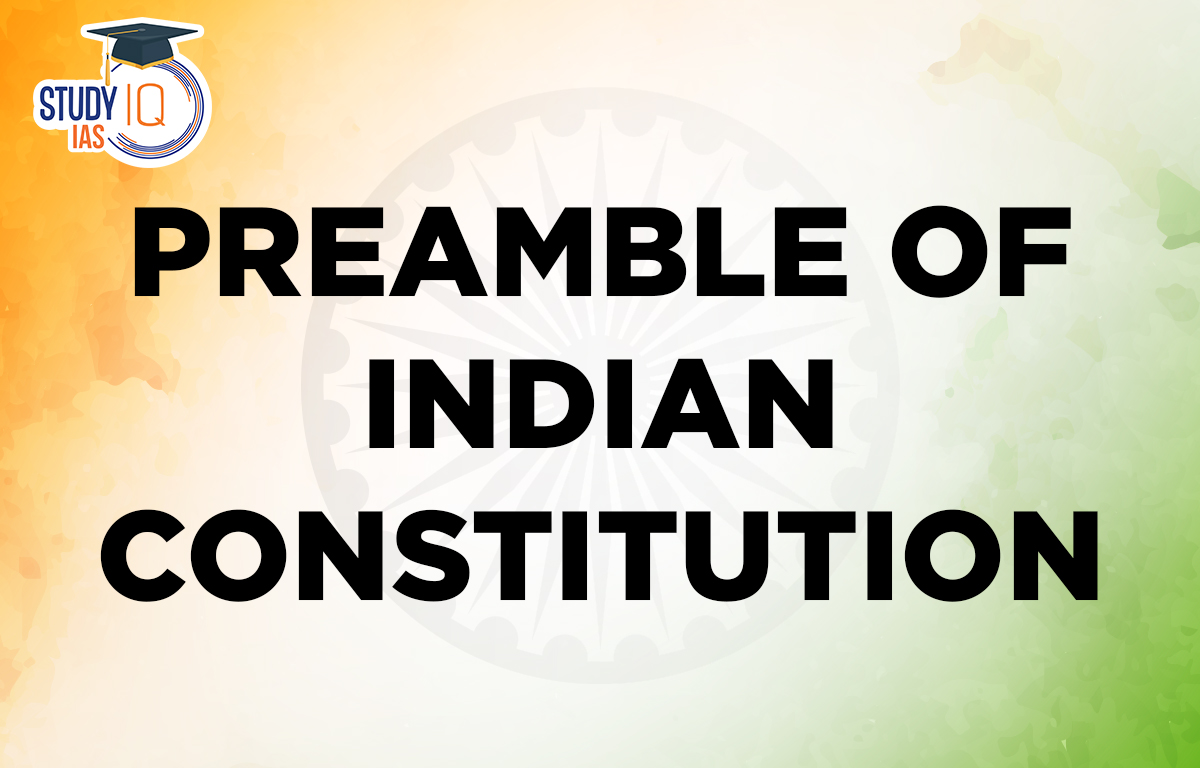Table of Contents
Preamble of Indian Constitution
The Constitution of India’s “Preamble” is a succinct introductory statement that outlines the document’s overarching goals and guiding principles. It also identifies the source of the document’s authority, i.e., the people. The Constituent Assembly approved it on November 26, 1949, and it went into effect on January 26, 1950. The Preamble of Indian Constitution is a succinct introduction that outlines the fundamental goals, tenets, and guiding principles of the document. The preamble provides information about the following:
- The constitution’s genesis
- The character of the Indian state.
- A description of its goals
- The date it was adopted
Preamble of Indian Constitution: Latest Update
Nearly 2.28 crore people have registered to read the Constitution’s preamble on September 15 in Karnataka. Karnataka Social Welfare Minister H C Mahadevappa nearly 2.28 crore people from all walks of life within the country and abroad, have registered to read the Constitution’s preamble on September 15 as part of the ‘International Day of Democracy’ celebrations. The intention is to make people, especially the youth understand the idea of the democracy and the constitution, and thereby they know the main purpose of the preamble, to lead a life with dignity, freedom and equality.
What is preamble of Indian Constitution?
The Preamble is the main and most effective introduction to the particular document, and it should be included in any form of beneficial book. Essentially, it is a statement that introduces the topic and generally gives you a wealth of information about it. The subject’s aim, philosophy, uses, ideas, and aspirations are essentially covered in the user manual, along with important principles and a description of the key goals. The Preamble provides examples of several types of information. It is the first item mentioned on the document’s front page. So, the Preamble’s primary and essential goal is that.
Salient Features of Constitution of India
Preamble of Indian Constitution Overview
The American constitution was the first to introduce Preamble in its Constitution. Preamble contains the summery or essence of the constitution. It also embodies the basic philosophy and fundamental values as political, moral and religious on which the Constitution of India is based. Preamble contains the noble vision of the Constituent Assembly and reflects the dreams and aspirations of the framers of the constitution. NA Palkhivala a constitutional expert and an eminent jurist called the Preamble as the ‘Identity Card of the Constitution.’ Check the overview of Preamble of Indian Constitution in the table provided below:
| Preamble of Indian Constitution Overview | |
| Particulars | Details |
| Preamble introduced by | Preamble was moved in the Constituent Assembly by Jawaharlal Nehru on 13 December 1946 as an Objective Resolution. |
| Accepted by Constituent Assembly on | It was accepted on 22 January 1947 |
| Adopted by Constituent Assembly on | It was adopted by the Constituent Assembly on 26 November 1949 |
| Preamble came into force on | 26 January 1950 |
| Preamble provides information about |
|
| Keywords in the Preamble |
|
| Amendment of the Preamble | By 42nd Constitutional Amendment Act 1976 which added 3 words in Preamble
|
| Preamble as Part of Constitution | In Kesavananda Bharti Case 1973, SC stated that Preamble is the Part of the Constitution and is subject to be amended. |
History of Preamble of Indian Constitution
The Preamble outlines the Constitution’s goals even though it is not legally binding and can be used to help understand the Articles where there is a linguistic ambiguity.
- Jawaharlal Nehru’s Objectives Resolution, which the Constituent Assembly ratified on January 22, 1947, established the principles that serve as the foundation of India’s Constitution.
- The Objectives Resolution laid the groundwork for India’s Constitution, which codified the fundamental values of equality, liberty, democracy, sovereignty, and cosmopolitanism.
- This strengthened the moral commitment to build a government that will fulfill the many promises made to the Indian people by the nationalist movement.
- This resolution, which was unanimously approved on January 22, 1947, served as the basis for the Preamble to the Constitution.
The ideals of the preamble include the core framework of our constitution. It emphasizes the essential ideas and philosophy of the Indian constitution.
Objectives of Preamble of Indian Constitution
Jawaharlal Nehru proposed the Objective Resolution in 1946, which outlined the constitutional framework. It was adopted on January 22, 1947. It influenced the Indian Constitution, and the Preamble of the Indian Constitution reflects its modified version. The fundamental principles that the objective resolution highlighted were:
- The Constituent Assembly’s determination to recognize India as an independent, sovereign, and republic;
- The creation of an Indian Constitution; and
- The goal of transforming all pre-independence Indian provinces into post-independence Indian states.
- To realize union with the power that will be distinct from those granted to such states;
- To realize residual powers, autonomy on such states as the Constitution of India reflects;
- For the Indian people to act as the source of power and authority of the sovereignty, and the independence
- To uphold justice, social, economic, and political equality of opportunity, as well as the freedoms of expression, association, association with others for a common purpose, and action, subject to the law and public morality before the law.
- To offer minorities, tribal and underdeveloped regions, as well as other downtrodden and backward sections, proper protections.
- To uphold the territorial integrity of the Indian Republic and its sovereign rights over land, sea, and air in accordance with international law and justice
- To advance international harmony and prosperity.
Components of Preamble of Indian Constitution
The Indian people are the Constitution’s ultimate source of authority, as stated in the Preamble. In the preamble, India is described as a sovereign, socialist, secular, and democratic republic. The Preamble seeks to provide justice, liberty, equality, and fraternity for all citizens in order to safeguard the nation’s integrity and togetherness. As stated in the preamble, it was adopted on November 26, 1949.
Important Articles of Indian Constitution

Keywords of Preamble of Indian Constitution
- We, the people of India : It represents the whole sovereignty of the Indian people. The term “sovereignty” refers to a state’s independent power, which is unaffected by the actions of any other state or outside force.
- Sovereign: The phrase indicates that India is an independent country with its own government and is not under the control of any other external entity. The country’s legislature has the authority to enact laws, but only within specific bounds.
- Socialist: The phrase refers to socialist goals being achieved using democratic means. It adheres to the idea of a mixed economy in which the public and private sectors coexist side by side. The 42nd Amendment of 1976 adds it to the Preamble.
- Secular: The phrase indicates that the government in India accords equal respect, safety, and support to all major religions. The Preamble of the Constitution was amended by the 42nd Constitutional Amendment in 1976.
- Democratic: The phrase emphasizes that the Indian Constitution has an established form that is based on the desire of the people as expressed through elections.
- Republic: The phrase implies that the people elect the state’s head of state. The President of India is the country’s elected head of state.
Present Status of Preamble of Indian Constitution
The Supreme Court has debated the preamble’s inclusion in the Constitution on numerous occasions. Reading the following two cases will help you understand it.
Berubari Case
It was used as a reference under Article 143(1) of the Constitution, which dealt with the Berubari Union’s implementation under the Indo-Pakistan Agreement, and in exchanging the enclaves that the panel of eight judges agreed to take into consideration.
The Preamble is the key to unlock the minds of the framers, the Court said in the Berubari case, but it cannot be regarded as a part of the Constitution. So it cannot be enforced in a court of law.
Kesavananda Bharati Case
In this instance, a bench of 13 judges was gathered for the first time to hear a writ petition. The Court determined that:
- The Constitution’s Preamble will now be regarded as a component of the document.
- Though not the ultimate authority or the source of any restriction or ban, the Preamble is significant in how laws and Constitutional provisions are interpreted.
- Therefore, it can be said that the Constitution’s preamble is a part of its introduction.
The Supreme Court has once again ruled that while the Preamble is an essential component of the Constitution, it is not immediately enforceable in an Indian court of justice. This ruling was made in the 1995 case of Union Government vs. LIC of India.
List of Prime Minister of India
Amendment of Preamble of Indian Constitution
After the Kesavanand Bharati case verdict, it was acknowledged that the preamble is a component of the Constitution and enacted the 42nd Amendment Act in 1976. Preamble can be changed because it is a part of the Constitution under Article 368, but its fundamental format cannot be changed. Currently, the 42nd Amendment Act of 1976 is the only amendment to the preamble.
Through the 42nd Amendment Act of 1976, the words “Socialist,” “Secular,” and “Integrity” were added to the preamble. Between “Sovereign” and “Democratic,” the terms “Socialist” and “Secular” were added. “Unity and Integrity of the Nation” was substituted for “Unity of the Nation.”
List of Vice Presidents of India
Preamble of Indian Constitution UPSC
- The Indian Constitution, which is currently in effect, has just one Preamble, 22 parts, 12 schedules, and 448 articles.
- The Objective Resolution, which Jawaharlal Nehru prepared in 1946, is referenced in the preamble of the Indian Constitution.
- The Supreme Court of India deemed the Preamble to be unconstitutional in the Berubari Case (1960).
- The Kesavananda Bharti Case further stressed that it is a component of the Indian Constitution.
List of Chief Ministers of India
Other Important Links


 SLAPP Suits: Meaning, Examples, Impact o...
SLAPP Suits: Meaning, Examples, Impact o...
 Finance Commission of India, Articles an...
Finance Commission of India, Articles an...
 High Number of Pending Cases in Supreme ...
High Number of Pending Cases in Supreme ...

























